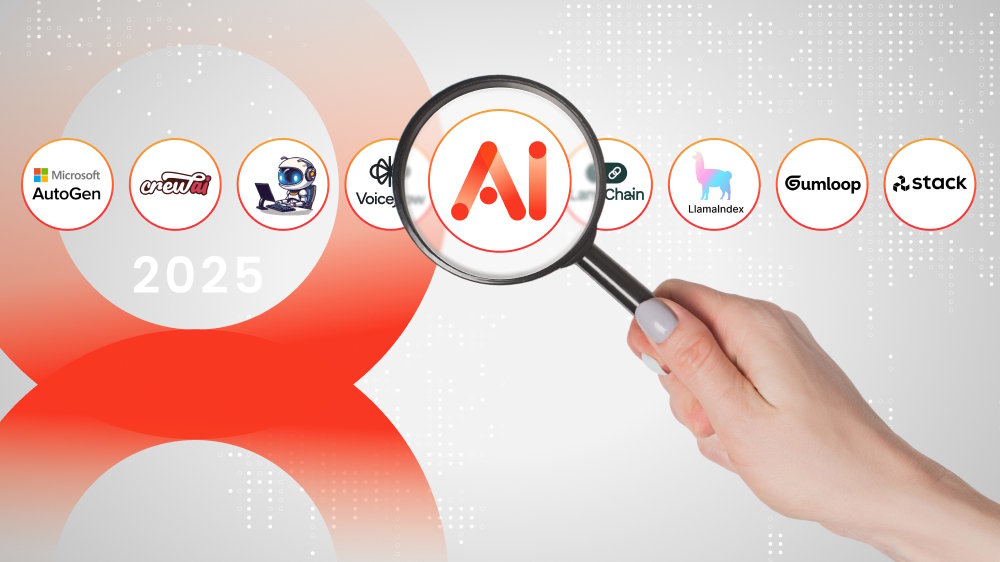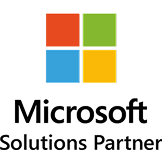
Data Analytics Cost: Where Does Your Money Really Go?
Ever wonder where your data analytics budget really goes? Here, we will unveil the key elements of data analytics expenditures and give a set of effective tips in the hope that you can receive maximum value for each dollar of that spending. Ultimately, we are going to talk in detail about the financial aspect of small, medium-sized, and big companies, and enable you to make an informed choice of whether to invest in data analytics services and allocate possible resources to achieve the most significant benefits.

Content Map
More chaptersThe global market for data analytics is booming due to the rapid adoption of AI, machine learning, and real-time processing technology, a sign that businesses of all shapes and sizes are increasingly depending on data to get an edge in the marketplace. In fact, some studies show that the majority of small and medium-sized businesses that use AI and analytics services report revenue growth.
But this powerful resource has a price tag, and for many business owners, especially those running smaller enterprises, the concern is not “Should we invest in data analysis?”, but “How much will it cost and whether or not we can afford it?”.
Trying to find a straightforward, explicit answer to “How much does data analytics cost?” is like navigating through a digital maze. The price can be drastically varied, from a few thousand dollars for a low-end project to hundreds of thousands or even millions for enterprise solutions. All these hinges on everything from the size of the company and the amount of data to the specific services and technologies required.
This article will be your guide, breaking down the true price of data analytics solutions. We will rise above software and consultant prices tags to reveal the numerous factors that go into the total investment, and provide real-life advice for small, medium and large businesses so that you can see where your money is truly going and, better yet, how to get the most out of each dollar spent.
The Core Components of Data Analytics Cost
Data analytics includes several crucial elements that make up the cost.
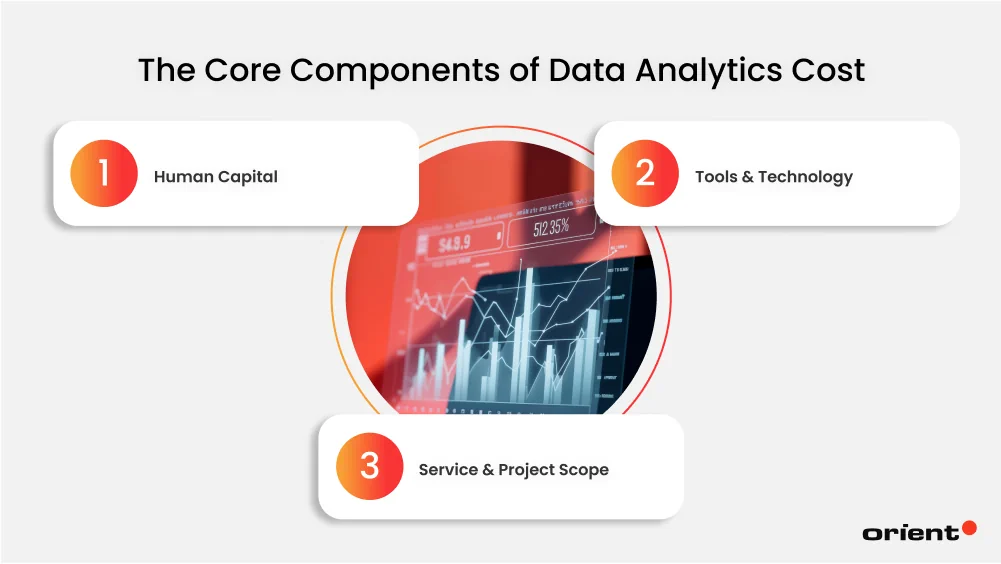
Human Capital
Talent is essential to any data analytics operation. The employment of highly qualified people is one of the greatest cost drivers, and these people include data scientists, machine learning engineers, data engineers, and business analysts. As an illustration, in the U.S., a senior data scientist has an average salary of over 130,000 dollars per year, and with specialized tasks involving artificial intelligence and predictive modeling, the compensation can go even higher.
Other costs are beyond salaries, as they involve the recruitment, onboarding, and further training. Since analytics tools have intensively changed over the years, constant learning is necessary to keep teams on top of updated systems and procedures. Moreover, companies tend to devote funds to cross-functional teams to overcome the disconnect between the technical understanding and the business strategy, further raising the costs of human resources.
Tools & Technology
The data analytics technological backbone is constructed out of a combination of both software and hardware product systems. Cloud-based services such as Amazon Web Services (AWS), Microsoft Azure, and Google Cloud Platform (GCP) provide scalable storage and computing resources, but their pay-as-you-go pricing structure can rapidly increase expenditure with the increase in the amount of data and processing demands. To give one example, a GPU-accelerated instance to run large-scale machine learning will set you back hundreds of dollars an hour.
Concerning the software side, analytics platform license costs, such as Tableau, Power BI, SAS, or Databricks, are expensive across the board. High-end subscriptions at the enterprise level are usually more costly and may feature such modules as real-time data streaming, automated reporting, and AI. There is also the cost of keeping compliance and security software, primarily in regulated industries, to ensure data privacy and governance standards are addressed.
Service & Project Scope
Cost is directly dependent on the scope of the analytics projects. An example of a sales performance dashboard may not take many resources, but a full-blown project on predictive analytics, like modeling customer churn or optimization of the supply chain for example, needs a tremendous amount of data preparation, algorithm development, and validation to be performed.
Timelines and staffing are also influenced by project complexity. Consider, for example, combining heterogeneous data sources across legacy systems, third-party APIs, and streaming data requires months of engineering effort. Development of custom models, particularly those found in specific business sectors such as healthcare or finance, usually demands industry-specific knowledge and exhaustive testing, which makes budgets even higher.
In addition, many organizations have an outsourced component of the analytics workflow to consulting firms or managed service providers. Such engagements may be of a few months’ duration to a several-year transformation effort, and the prices are delivered based on deliverables, time, or performance results.
Data Analytics Costs by Business Size
Depending on either the size or complexity of the business, the expenditure of enacting data analytics remedies can differ widely. Below is the breakdown evaluation of the data analytics cost difference in small, mid-sized, and large businesses.
Small Businesses
Small organizations work on limited budgets and tend to have narrower data requirements in comparison to large organizations.
Typical Needs
Analytics solutions that are focused, actionable, and a breeze to implement are normally practical for small businesses. The needs are most frequently as follows:
- Basic Reporting: This would entail monitoring such key performance indicators (KPIs) as volume of sales, stock turnover, and employee productivity. Manual reporting can be done via Excel or Google Sheets, whilst such visual dashboards can be automated using software like Looker Studio.
- Website Analytics: It is essential to know how the users are interacting with the site and their source of traffic and bounce rates as well as funnel conversion rates to promote digital marketing. Google Analytics has been the preferred tool by most small businesses, given that it comes with powerful capabilities with no pricing tag whatsoever.
- Customer Insights: Knowing the demographics, buying behaviors, and customer inputs assists in product and service customization. This usually entails the merging of the CRM data with analytics services so as to discover trends and segment audiences well.
These requirements are basic and usually do not need the infrastructure of an enterprise, which means that they are available given the proper tools and planning.
Cost Range Estimates
The cost of data analytics varies significantly according to the extent, complexity, and degree of customization that is necessary. Let us have it realistically broken down:
| Type of Engagement | Estimated Monthly Cost | Description |
|---|---|---|
| Basic DIY Setup (Free Tools) | $0 – $200 | Using free platforms like Google Analytics and Looker Studio with internal staff |
| Freelancer or Small Firm Engagement | $1,000 – $5,000 | Hiring external help for setup, dashboard creation, or periodic analysis |
| Mid-Level Retainer (Ongoing Support) | $5,000 – $15,000 | Monthly contracts with boutique analytics firms for continuous insights and reporting |
| One-Time Project (Custom Analysis) | $2,000 – $10,000 | Specific deep-dive projects like customer segmentation or predictive modeling |
These rates are standard rates in the marketplace may differ depending on the geography of a certain market, industry, and the complexity of the data involved.
Medium-Sized Enterprises
As medium-sized enterprises look to place their competitive advantage and increase efficiency and find growth potential, they increasingly use data analytics. Nevertheless, the financial investment required can be quite variable depending on the scope, tools, and the strategy deployed.
Typical Needs
Medium-sized companies tend to prefer highly advanced analytics that are beyond fundamental reporting. Their requirements normally consist of:
- Sales Performance Analysis: Measuring the conversion rates, customer acquisition costs, and the lifetime value across various channels. This is usually done by segmenting customer data to determine the high-value segments and the seasonal influences.
- Marketing Attribution and ROI: The ability to determine the effectiveness of the campaign across media (e.g., Google Ads, social media, email), based on multi-touch models. Predictive analytics can be employed to determine the success of past campaigns.
- Operational Efficiency Metrics: Tracking performance of the supply chain, inventory turnover, and productivity of the workforce. Department heads often get custom dashboards to help visualize KPIs in real time.
- Predictive Modeling: Using machine learning to predict customer churn and make sales or pricing decisions. Some models make demands on clean, well-organized data, and some are subject to iterative perfection.
Cost Range Estimates
The monetary investment associated with data analytics also fluctuates based on the complexity and the level of undertaking:
| Scope of Work | Estimated Annual Cost or Per Project |
|---|---|
| Basic dashboard setup and reporting | $15,000 – $30,000 |
| Department-level analytics with forecasting | $30,000 – $60,000 |
| Enterprise-wide integration and predictive modeling | $60,000 – $100,000+ |
These figures normally depict licensing, consultation charges, and staffing within the internal framework. As an example, a company that deploys predictive analytics in sales and marketing can expect to spend over $80,000 per year, particularly where external data scientists are employed.
Large Enterprises
Data Analytics Costs for Large Enterprises
With the expansion of large businesses to geographies and across business verticals, data analytics is becoming a central pillar of strategy. These entities need to have highly developed systems that can support large amounts of data and provide real-time analyses, as well as power advanced machine learning models. The financial investment demonstrates the level of thinking and the ambition of those initiatives.
Typical Needs
They usually have the following needs:
- Enterprise-Wide Data Strategy: This will entail harmonizing analytics objectives and business goals among other departments, such as finance, HR, supply chain, marketing, and customers. It has had to be centrally governed and have uniform definitions of data to create uniformity.
- Advanced ML/AI Capabilities: Predictive maintenance, customer behavior modeling, fraud detection, and demand forecasting are common use cases. These require scalable machine learning pipelines, often built using platforms like Databricks, AWS SageMaker, or Google Vertex AI.
- Real-Time Analytics: For industries like retail, logistics, and finance, real-time decision-making is critical. This involves streaming data architectures using tools such as Apache Kafka, Flink, or Azure Stream Analytics to process and visualize data instantly.
- Complex Data Integration: Enterprises typically operate dozens of systems — ERP, CRM, POS, IoT platforms, and more. Integrating these disparate sources into a unified data warehouse or lakehouse architecture demands robust ETL/ELT pipelines and metadata management.
Cost Range Estimates
The price range of data analytics in the context of large-scale enterprise is broad, and it depends on the individual feature and the ambitions of a certain initiative:
| Scope of Analytics Investment | Estimated Annual Cost or Project Budget |
|---|---|
| Departmental analytics with real-time dashboards | $100,000 – $250,000 |
| Enterprise-wide integration and ML deployment | $250,000 – $500,000+ |
| Full-scale transformation with AI, cloud migration | $1 million – $5 million+ |
These figures incorporate software licensing (i.e., Snowflake, Tableau, and SAS), cloud facilities (i.e., AWS and Azure), personnel, and consultancy charges. As an example, an international retail company operating in-store analytics in hundreds of stores by using real-time analytics could cost as much as 2 million dollars a year.
Factors That Influence Data Analytics Service Costs
There are several major elements beyond the business size that influence the price tag of data analytics services. These factors have direct effects on the resources, time and expertise needed in the success of a project.
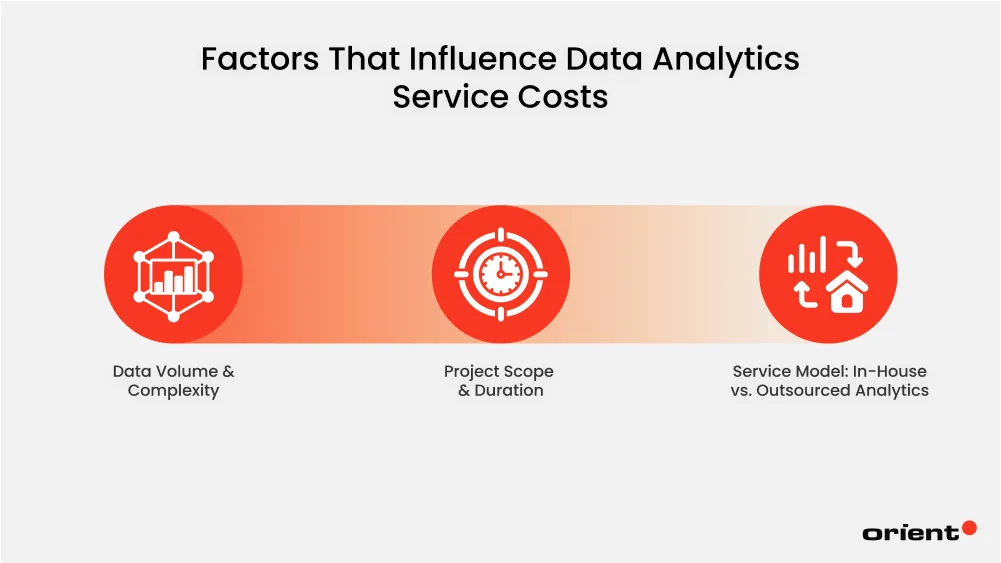
Data Volume & Complexity
How much data you possess, and the quality of such data are also significant cost factors. It’s a simple equation: The more data and the messier the data = the more cost. A firm that installed a couple of hundred customer records in a tidy, structured Excel will dramatically underspend a company that is swamped in terabytes of unstructured data, web traffic, social media feeds, and sensor log data.
Mass data demands more capable and costly storage systems, including cloud-based data warehouses, and also increases processing time. Moreover, the raw nature of the data, such as unstructured text files or image files, compared to structured numeric data, requires special tools and specialized skills to clean and process.
Project Scope & Duration
The size and the time it takes to complete your analytics project are important determinants of cost. A single, stand-alone project like creating an individual dashboard to measure the results of a particular marketing campaign would cost significantly less compared to an ongoing complex project, like coming up with a real-time predictive model that would measure customer churn and need ongoing support and upgrades.
A project with a well-defined and narrow scope is very likely to be delivered with certainty under a fixed-price contract. On the other hand, a long-term project or an open-ended scope of work may involve a monthly retainer or an hourly rate that can be adjusted to meet the changes in the needs and appear as a more expensive scope of overall cost.
Service Model: In-House vs. Outsourced Analytics
One of the critical financial decisions is based on the choice of whether to assemble an in-house data analytics team or outsource the task to an external vendor. Every model has different benefits and demerits that impact your pocket.
- In-House Analytics: Having an in-house department means you have full visibility and direction of your data initiatives and are able to maintain institutional knowledge within this firm. However, this approach is accompanied by high initial and continuous costs, such as competitive salaries, benefits, and high costs of the software licenses required to accommodate one full team.
- Outsourced Analytics: With outsourcing, you have access to specialized analytics that only need to be on-hand when needed, without having to pay a full-time salary. The disadvantages are an indirect level of control over the schedules and deliverables of projects, possible data security issues when sensitive data is also managed by a third party, and dependency on a third-party timeline and priorities.
| Feature | In-House Analytics | Outsourced Analytics |
|---|---|---|
| Control | High; direct oversight of projects. | Lower; reliance on a third party. |
| Cost | High upfront and ongoing costs (salaries, software). | Lower initial investment; project-based or retainer fees. |
| Expertise | May have skill gaps; requires constant training. | Access to specialized, niche expertise. |
| Flexibility | Less flexible; fixed team size. | Highly flexible; scale up or down as needed. |
| Knowledge | Institutional knowledge stays within the company. | Knowledge resides with the third party. |
| Security | Full control over data security. | Potential for data security concerns. |
The Hidden Costs You Need to Know
Although the initial expenses of both human capital and technology can be well outlined, the latter are characterized by a series of unknowns that can greatly increase the budget of a business in terms of data analytics. These are some of the hidden costs that are always neglected when carrying out financial plans.
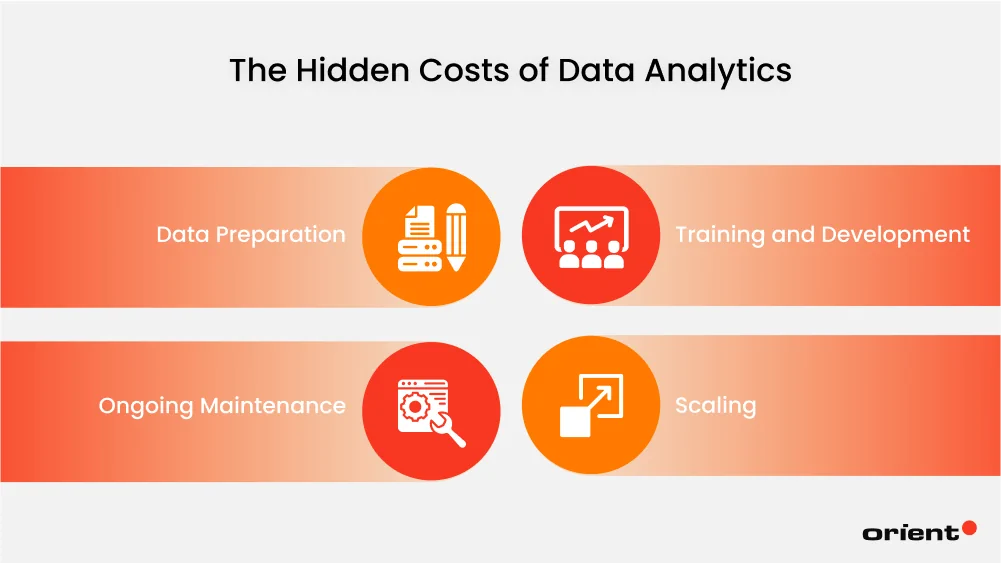
Data Preparation
Among the most underrated costs is data preparation. The businesses usually presume that their data is in a state that is ready to be analyzed; however, in real life, raw data is usually dirty, incomplete, and inconsistently formatted. Cleaning, transforming, and organizing data that you can use is incredibly time-consuming and labor-intensive. Analysts and data scientists often devote time to this part of their work at a rate between 50% to 80%, meaning a large subset of your data analyst budget is allocated to the data janitor.
Training and Development
It is useless to invest in new tools and services and not make your team understand how they can use them. Training and development are not easily noticed, but they are critical to the success of your data initiatives, and they should not be overlooked. This consists of the price of training its employees to utilize new dashboarding software, such as Tableau or Power BI, or educating company executives on how to read the reports that they are being sent. In addition, professional development will also be required to maintain the skills of your internal staff, who would need to keep up with rapid changes in technology and best practices on the topic of data analytics.
Ongoing Maintenance
Once a data analytics project has been executed, the expenditures do not vanish into the air. Maintenance is an extremely important ongoing cost. Data pipelines and dashboards all need frequent maintenance to run smoothly. Considering the example of a company that changes its API, which is accessed by the e-commerce portion of the company, a new data pipeline consuming the sales information would cease to work, and it would require the time of an engineer to repair it. Lack of constant maintenance of your analytics system would soon make it prone to failure, and the initial investment will go to waste.
Scaling
Lastly, there is the hidden cost of scaling that occurs when a business expands and has more complicated data demands. As the volume of data grows, you might want to migrate out of a basic data storage system into a scalable data warehouse, which is more costly. Similarly, the original predictive model, successful with a certain line of its products, may have to be replaced or polished to accommodate new products or a customer base that is bigger and has a wider variety, and this formation process can incur unexpected costs of development. Such costs of scale are unpredictable and a given reality in the future of a company.
Practical Strategies to Lower Your Data Analytics Costs
Effective control of data analytics expenses is vital to any business, particularly to companies with limited budgets. This can be done through playing intelligent tricks so that you get valuable insights without straining the budget.
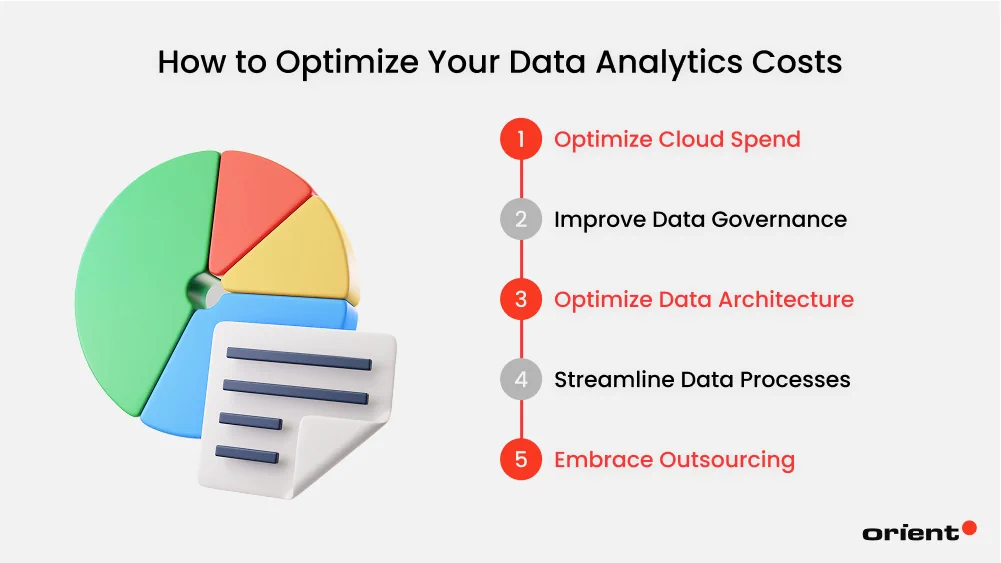
Optimize Cloud Spend
Cloud services, such as AWS, Azure, and Google Cloud, provide very powerful analytics, yet without a disciplined approach, they can get extremely expensive. The first thing that an organization can do to manage cloud spending is to deploy real-time monitoring tools like AWS Cost Explorer or Azure Cost Management to monitor the usage patterns and find potential areas of underutilized resources.
As an example, idle virtual machines or oversized storage buckets are easy to miss yet can eat budgets in silence. The selection of services is vital as well, to switch to serverless architecture, such as AWS Lambda or Azure Functions, to use when there are occasional workloads that scale on their own and do not require paying for unused processing resources.
Also, the possibility of automatic cost control through tools such as Terraform that cover cost policies or external services such as CloudHealth may impose the limits of the specific budget, remove resources that were not used, and give warnings to teams before they go over budget. Such aggressive strategies ensure that cloud analytics will be lean and scalable.
Improve Data Governance
The issue of poor quality of data is the most costly and time-consuming issue in analytics. An investment in data governance systems and frameworks that focus on quality at the source would dramatically lower the requirement of downstream cleansing and transformation.
To give one example, by applying validation rules at the data entry stage, including consistent format requirements, mandatory fields, and range requirements, it would ensure that propagation of errors does not occur. Profiling and cleansing can be automated with tools such as Talend or Informatica, but profiling efficiency depends on upstream quality.
Furthermore, the allocated data ownership functions and responsibilities in departments make data stewards across departments gain integrity over a period. Projects that mitigate the amount of so-called “dirty data” can save hours of manual cleaning time, reduce the processing expense, and reduce time-to-insight.
Optimize Data Architecture
Cost-efficient analytics is built on a well-designed data architecture. The storage of fragmented data silos, duplicated pipelines, and databases that are not well indexed drives up storage bills and slows queries. Replacing legacy data infrastructure with a modern data architecture, such as a data lakehouse design with Databricks or Snowflake, can enable storage and compute to be merged, taking out duplication and increasing scale.
Also, data can be partitioned and stored in columnar formats (e.g., Parquet), and some data lifecycle policies (e.g., archiving stale data) can dramatically decrease storage and query costs. Whether you have fully optimized your ETL pipelines before optimizing on the communications layer should also be considered in organizations; any inefficient joins or transformations that are not needed add up the costs in terms of compute. Regular review of the architecture components will ensure that the system develops in line with the business requirements, but does not swell the costs.
Streamline Data Processes
The data analytics pipeline usually consists of different steps: ingestion, transformation, modeling, and visualization. All these stages have the possibility of optimization.
As an example, latency and resource efficiency can be diminished by replacing batch ETL jobs with event-driven streaming via Apache Kafka or AWS Kinesis. Likewise, to centralize metadata so that redundant work can be avoided and the reliability of these pipelines can be improved, orchestration tools such as Apache Airflow or Prefect can be used.
Automation of repetitive requirements like schema validation, anomaly detection, and report generation not only saves time but also has the added advantage of requiring less manual intervention, as it can be very costly and inaccurate. Streamlining these functions will reduce the amount of maintenance time an analytics team spends and provide more insight creation.
Embrace Outsourcing
Outsourcing is often an excellent solution to the motivational costs of data analytics for many companies, especially small and medium-sized firms. The outsourcing of data analytics to specialized partners may be a strategic decision to cut down the cost without compromising quality.
Companies, such as Orient Software, provide customized analytics services through the use of offshore skills, tooling, and knowledge. The outsourcing of services and products will allow an organization to cut the cost of training and recruiting organizational staff, particularly for short-lived or specialized assignments. As a good example, Orient Software offers such scalable analytics solutions as data engineering, machine learning, and other options at a small part of the price of having an entire in-house team.
Further, outsourcing partners deliver predesigned structures/accelerators and thus shorten the development time and enhance ROI by optimizing effort spent. Outsourcing reduces the cost of the operations of an organization besides increasing agility and innovation when selected wisely.


